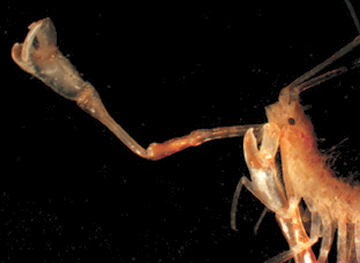The first survey of life in deep waters around Antarctica has turned up hundreds of new species and a lot more variety than explorers had expected.

A team of scientists from eight countries sampled bottom dwellers during three cruises in the ocean south of the Atlantic. Some of the researchers offer their “first insights” into these Southern Ocean depths in the May 17 Nature.
The new work is the “first systematic and comprehensive study” of biology in the south polar depths, says one of the study leaders, Angelika Brandt of the Zoological Museum in Hamburg, Germany.
A researcher not on the team, Richard Aronson of Dauphin Island Sea Lab in Alabama, welcomes the work “as a significant step forward…. The last great frontiers in marine biology are the deep sea and Antarctica.”
The Southern Ocean team spent weeks aboard the German research icebreaker Polarstern in 2002 and 2005. The ship’s low center of gravity keeps it stable enough for researchers to work in all but the heaviest seas. “It sits there like a bus,” says Brigitte Ebbe of the Senckenberg Research Institute in Bonn, Germany.
The team sampled deep-sea life by dropping devices that scooped sediment and its inhabitants from the bottom. It took the scientists 6 to 8 hours to lower the device and then bring up a single scoop. The ship stopped above 40 sampling sites at depths ranging from 774 to 6,348 meters.
Ebbe says researchers often speak of the deep ocean as beginning around 1,000 m, below which there’s a largely undiscovered world. In any water that deep, “half the species are new to science,” she says.
The Southern Ocean offered even more unknowns, the team reports. Of the 100 or more species of the small crustaceans called ostracods that the team found, some 70 percent are new to science. Of the 674 marine isopods—little crustaceans related to pill bugs—585 are new.
Life wasn’t abundant down there, but it was varied. The survey turned up more new isopod species than had been found in the past century of exploring the entire Antarctic continental shelf, says Brandt.
The diversity was indeed a surprise, she adds. Analyses of mollusks and isopods in the Northern Hemisphere have inspired the idea that diversity dwindles the closer a habitat is to the pole. So far, “we doubt that,” she says.
“For the first time, we have a huge data set on the Southern Ocean deep-sea diversity,” says Sven Thatje of the University of Southampton in England, a polar ecologist not on the team. He says that he looks forward to using the data to test hypotheses about the development of Antarctic marine ecosystems.
For the newfound creatures, “the big question that remains is, ‘How do they make a living?'” says Ebbe. Deep-sea creatures anywhere typically survive on debris settling from above, what biologists call “marine snow.” The debris “has usually already been through two or three bodies on the way down, so there’s not much nutrition left,” she says.
“The take-home message is that there is no place on this Earth that is not teeming with life,” says Ebbe.






